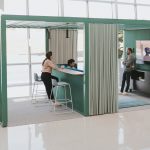Biophilic Design
In the 1980’s, a scholar named Edward O. Wilson popularized the concept of biophilic design in architecture and interior design. Biophilia means love of life or living things. As humans, we have an innate connection to nature and the natural world. Biophilic design incorporates nature and natural elements into workspaces, improving the physiological and psychological health of employees. This has become increasingly important in today’s world, where Americans are often spending 90% of their time inside.
In fact, according to the Global Impact of Biophilic Design in the Workplace study, 58% of offices have no live plants and 47% of employees have no natural light. One-third of employees consider these deciding factors in whether or not they accept a job offer. Not only does bringing natural elements in the workplace have an effect on recruitment and retention, there are a number of other benefits as well.
The Benefits
There are many benefits that come from improving the connection to nature in office design including increasing productivity, boosting creativity and decreasing employee absences. Biophilic Design is not only beneficial in office workspaces. It also has many benefits in educational and healthcare design as well. Recent studies have shown that biophilic design in classrooms and schools has resulted in 20-25% increases in learning, improved test results, concentration and attendance. In healthcare environments, in areas where biophilic design was incorporated pain medication use was decreased by 22% and patients recovery times were reduced by 8.5%.
Here are 4 Ways to Incorporate Biophilic Design into your Space
1 – Provide Views to Nature. To give employees a view to nature, windows should be designed and placed to provide easy and unobstructed views of nature and outdoor areas. Try to position workstations so that people can see out the windows and benefit the most from natural lighting.
2 – Blur the transition from Indoor to Outdoor Spaces. Wherever possible, try to extend the workspace into the surrounding landscape. This can be accomplished by terraces, courtyards, balconies and porches. Provide seating and pathways that lead to these areas so that people will want to use them.
3 – Decorate with Potted Plants. Using a potted plants, interior gardens and water features in your workspace will put your staff in closer contact with nature. By connecting employees with the outdoors, they will be more productive, their performance will increase and they are generally happier at work.
4 – Use Natural Materials and Natural Art. Using natural materials such as wood grain and patterned stone can bring a natural element into your design especially where views of nature aren’t possible. Natural artwork can also have this same effect. It is important to include both natural materials and artwork that enhances your employees connection with nature, in areas of your workspace that do not have access to windows.










